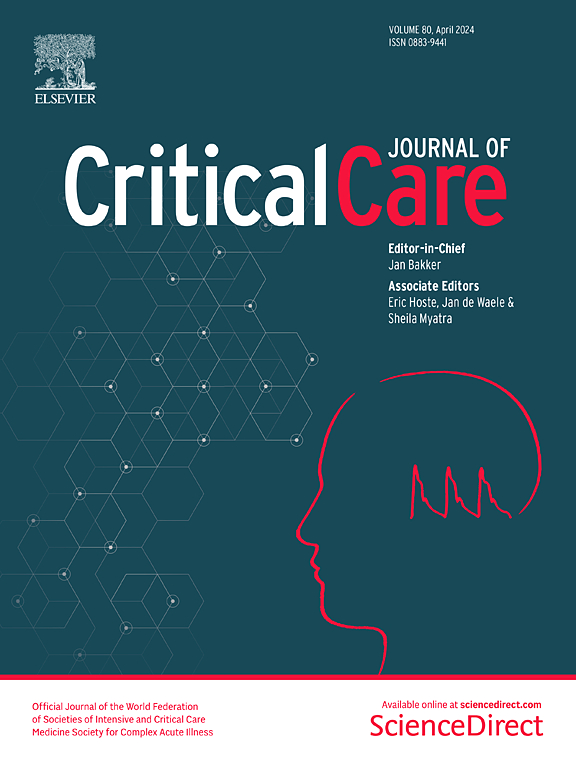The urea-to-creatinine ratio as an emerging biomarker in critical care: a scoping review and meta-analysis
IF 8.8
1区 医学
Q1 CRITICAL CARE MEDICINE
引用次数: 0
Abstract
Severe protein catabolism is a major aspect of critical illness and leads to pronounced muscle wasting and, consequently, extended intensive care unit (ICU) stay and increased mortality. The urea-to-creatinine ratio (UCR) has emerged as a promising biomarker for assessing protein catabolism in critical illness, which is currently lacking. This review aims to elucidate the role of UCR in the context of critical illness. This scoping review adhered to the PRISMA Extension for Scoping Reviews guidelines. A comprehensive literature search was conducted on the 3rd of September 2024, across Embase, PubMed, ScienceDirect, and Cochrane Library to identify studies related to (1) critically ill adult patients and (2) reporting at least a single UCR value. A meta-analysis was conducted for ≥ 5 studies with identical outcome parameters. Out of 1,450 studies retrieved, 47 were included in this review, focusing on UCR's relation to protein catabolism and persistent critical illness (10 studies), mortality (16 studies), dietary protein interventions (2 studies), and other outcomes (19 studies), such as delirium, and neurological and cardiac adverse events. UCR is inversely correlated to muscle cross-sectional area over time and associated to length of ICU stay, emphasising its potential role in identifying patients with ongoing protein catabolism. A UCR (BUN-to-creatinine in mg/dL) of ≥ 20 (equivalent to a urea-to-creatinine in mmol/L of approximately 80) upon ICU admission, in comparison with a value < 20, was associated with a relative risk of 1.60 (95% CI 1.27–2.00) and an adjusted hazard ratio of 1.29 (95% CI 0.89–1.86) for in-hospital mortality. UCR elevations during critical illness potentially indicate muscle protein catabolism and the progression to persistent critical illness, and high levels at ICU admission could be associated with mortality. UCR increments during ICU stay may also indicate excessive exogenous dietary protein intake, overwhelming the body's ability to use it for whole-body or muscle protein synthesis. Dehydration, gastrointestinal bleeding, kidney and liver dysfunction, and renal replacement therapy may also influence UCR and are considered potential pitfalls when assessing catabolic phases of critical illness by UCR. Patient group-specific cut-off values are warranted to ensure its validity and application in clinical practice.尿素与肌酐比值在重症监护中作为一个新兴的生物标志物:一项范围回顾和荟萃分析
严重的蛋白质分解代谢是危重疾病的一个主要方面,并导致明显的肌肉萎缩,因此,延长重症监护病房(ICU)的住院时间和死亡率增加。尿素与肌酐比值(UCR)已成为评估危重疾病中蛋白质分解代谢的一种有前景的生物标志物,这是目前所缺乏的。本文旨在阐明UCR在危重疾病中的作用。本次范围审查遵循PRISMA范围审查扩展指南。我们于2024年9月3日在Embase、PubMed、ScienceDirect和Cochrane Library进行了全面的文献检索,以确定与(1)危重成人患者和(2)报告至少一个UCR值相关的研究。对结果参数相同的≥5项研究进行meta分析。在检索到的1450项研究中,47项纳入本综述,重点关注UCR与蛋白质分解代谢和持续性危重疾病(10项研究)、死亡率(16项研究)、饮食蛋白质干预(2项研究)和其他结果(19项研究)的关系,如谵妄、神经和心脏不良事件。随着时间的推移,UCR与肌肉横截面积呈负相关,并与ICU住院时间有关,强调了其在识别持续蛋白质分解代谢患者中的潜在作用。ICU入院时,UCR(尿素对肌酐(mg/dL))≥20(相当于尿素对肌酐(mmol/L)约为80),与UCR < 20相比,住院死亡率的相对风险为1.60 (95% CI 1.27-2.00),调整后的风险比为1.29 (95% CI 0.89-1.86)。危重疾病期间的UCR升高可能表明肌肉蛋白分解代谢和持续危重疾病的进展,ICU入院时的高水平可能与死亡率有关。ICU住院期间的UCR增加也可能表明过量的外源性膳食蛋白质摄入,超过了身体使用它进行全身或肌肉蛋白质合成的能力。脱水、胃肠道出血、肾脏和肝脏功能障碍以及肾脏替代治疗也可能影响UCR,并且在通过UCR评估危重疾病的分解代谢阶段时被认为是潜在的陷阱。为确保其在临床实践中的有效性和应用,必须保证患者群体特定的临界值。
本文章由计算机程序翻译,如有差异,请以英文原文为准。
求助全文
约1分钟内获得全文
求助全文
来源期刊

Critical Care
医学-危重病医学
CiteScore
20.60
自引率
3.30%
发文量
348
审稿时长
1.5 months
期刊介绍:
Critical Care is an esteemed international medical journal that undergoes a rigorous peer-review process to maintain its high quality standards. Its primary objective is to enhance the healthcare services offered to critically ill patients. To achieve this, the journal focuses on gathering, exchanging, disseminating, and endorsing evidence-based information that is highly relevant to intensivists. By doing so, Critical Care seeks to provide a thorough and inclusive examination of the intensive care field.
 求助内容:
求助内容: 应助结果提醒方式:
应助结果提醒方式:


